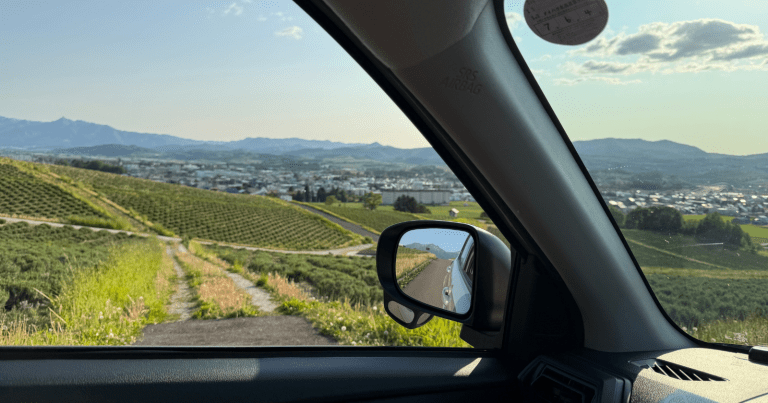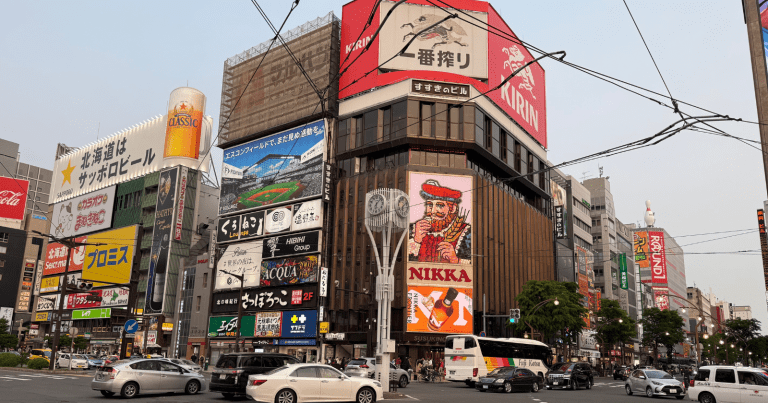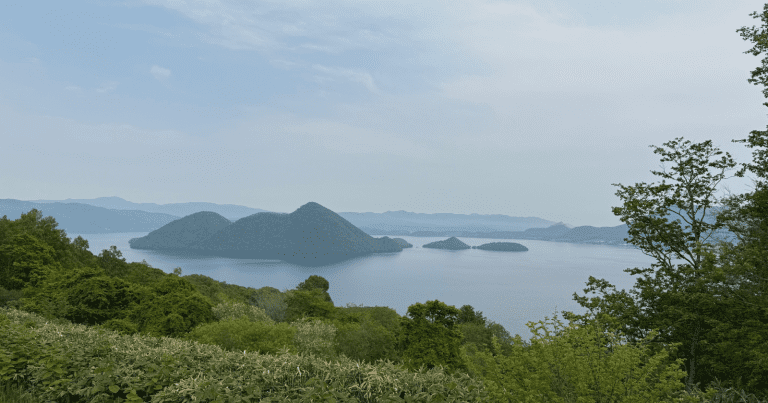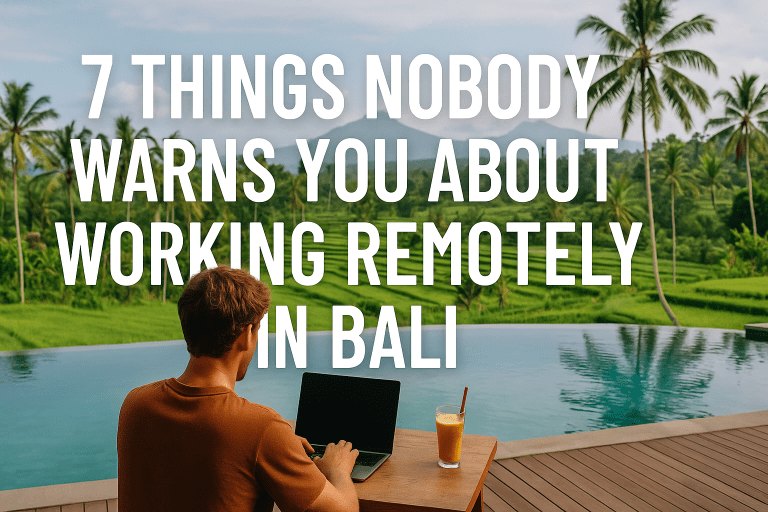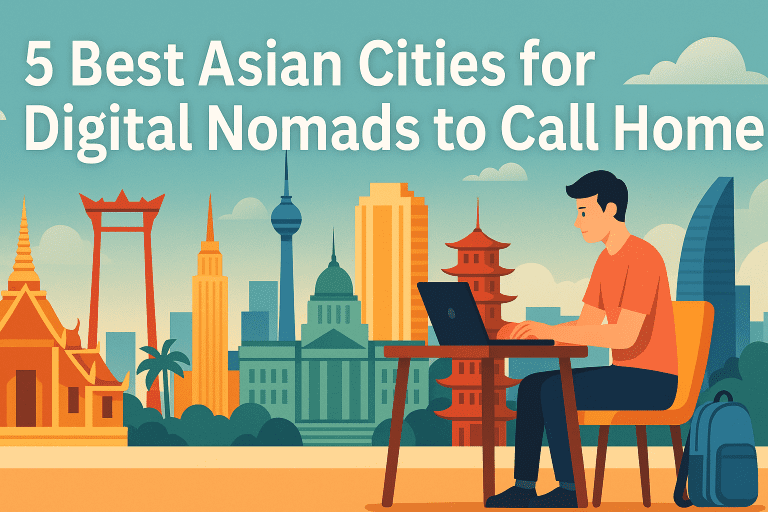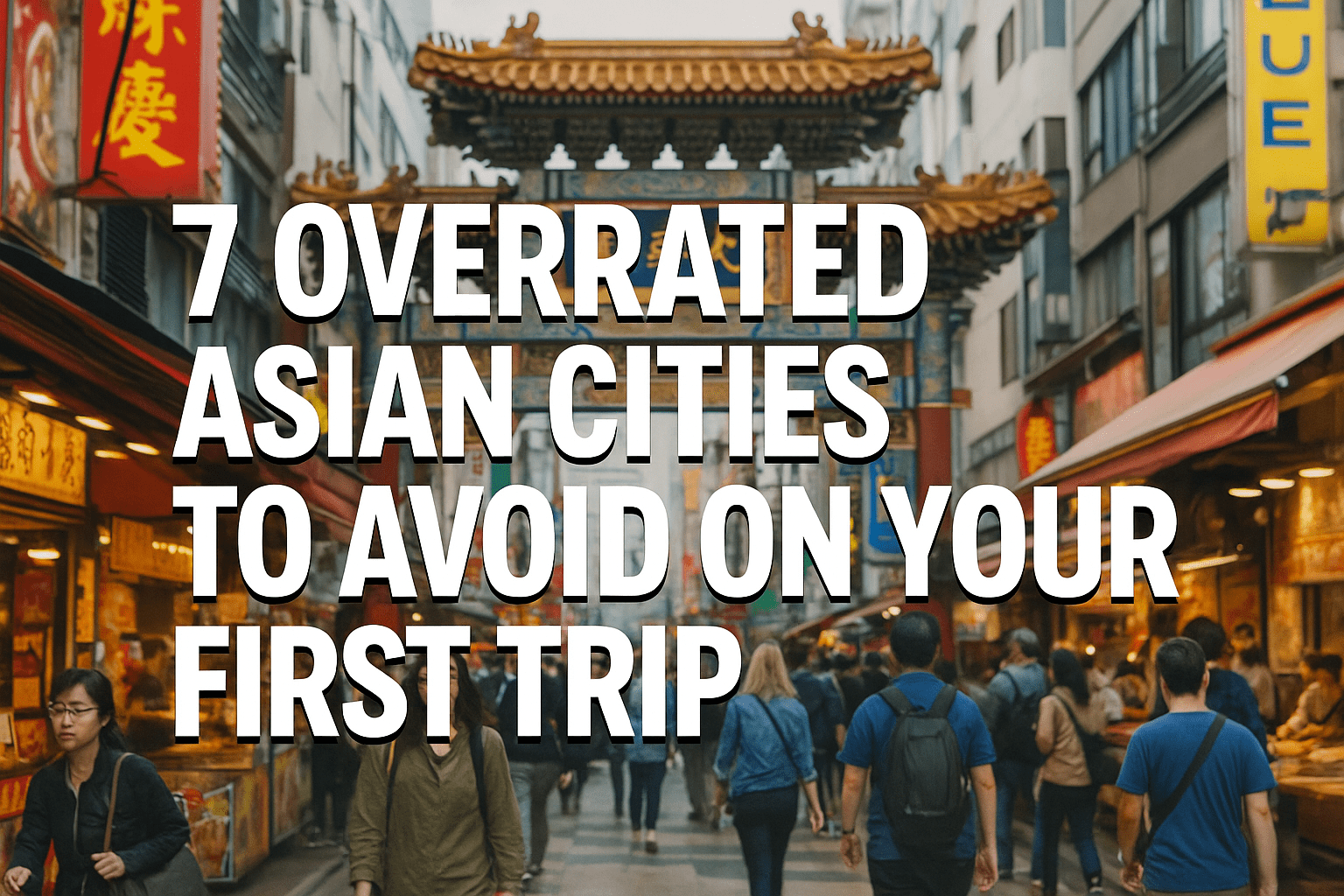
Alright, let’s cut to the chase. You’re planning your first big trip to Asia, and you’re probably drowning in lists of “must-see” places. Every travel blog, every friend who went backpacking once, they all have their favorites. And look, many popular spots are popular for a reason – they’re fantastic!
But here’s a little secret from someone who’s lived and traveled extensively across this incredible continent: not every famous city is the ideal introduction to Asia, especially on your very first trip. Some are awesome, yes, but they come with unique challenges that can easily overwhelm a first-timer, making your initial experience more stressful than magical. My goal is to help you sidestep those potential frustrations and make your first-time travel in Asia as smooth, enjoyable, and genuinely insightful as possible. We’re talking about traveling smarter, not harder. And sometimes, that means knowing which famous stops might be better saved for trip number two or three.
So, let’s dive into 7 overrated Asian cities that, while great places eventually, might be less than ideal for dipping your toes into the Asian travel pool. We’ll cover why, and more importantly, what you can do instead or how to navigate them if they’re unavoidable parts of your itinerary.
Why “Overrated” Needs Context for a First Trip
Before we start naming names, let’s clarify. When I say “overrated Asian cities for a first trip,” I don’t mean they’re bad places. Far from it! Many are world-class destinations. The “overrated” part comes from the common perception that they are the best or easiest starting points, when in reality, their popularity often brings crowds, inflated prices, specific logistical hurdles, or a particular vibe that might not be the most representative or welcoming introduction to Asia’s incredible diversity.
Think of it this way: you want your first bite of a diverse banquet to be something delicious and accessible, not necessarily the dish with the most complex flavors or the spiciest kick that might burn your tongue. These cities are often the latter for a newbie.

Strategy Set 1: The Big, The Busy, and The Pricey
Our first set of cities represents places that are major international hubs, famous globally, but often come with overwhelming scale, intense pace, or significant cost that can be jarring for someone just finding their feet in Asia.
1. Bangkok, Thailand
Ah, Bangkok. The city of dazzling temples, bustling markets, crazy nightlife, and… intense sensory overload. Bangkok is an absolute beast of a city, vibrant and endlessly fascinating. But for a first-timer? It can be A LOT.
Why it can be overrated for a first trip: The sheer scale and chaos. Navigating the city’s various transport systems (BTS, MRT, boats, taxis, tuk-tuks – all with different rules and potential for scams) can be stressful initially. Tourist areas like Khao San Road can be total traps, presenting a very artificial version of Thailand. The heat and humidity can be relentless, and simply crossing the street can feel like a near-death experience.
The savvy traveler approach: If Bangkok is unavoidable (it’s a major flight hub), limit your time there. Focus on specific, manageable neighborhoods rather than trying to see everything. Use ride-sharing apps with fixed prices to avoid taxi scams. Consider starting your Thailand experience in a slightly less overwhelming city like Chiang Mai (more relaxed, cultural focus) or even heading straight to an island or coastal area for a gentler introduction before tackling BKK chaos later.
One time, on my very first solo trip to Asia, I arrived in Bangkok utterly unprepared for the humidity and the aggressive tuk-tuk drivers immediately outside the train station. Within an hour, I was sweating profusely, lost, and arguing over a fare. It was a harsh lesson in arriving wide-eyed and trusting everyone. Planning specific transport methods and having offline maps ready would have saved me a lot of initial stress.
2. Bali, Indonesia
Bali. The Island of the Gods. Picture-perfect rice paddies, stunning beaches, spiritual retreats. It’s the dream destination for many. And it is beautiful. But it has changed dramatically, and what many first-timers expect isn’t always what they find, especially in the most famous areas.
Why it can be overrated for a first trip: Mass tourism and the digital nomad influx have transformed key areas like Canggu, Seminyak, and Ubud into international bubbles that feel less traditionally “Balinese” and more like hipster havens or crowded resorts. Traffic is notoriously bad, making simple journeys take hours. Prices for tourist services can be surprisingly high compared to other parts of Indonesia or Southeast Asia. It can feel less like exploring a unique culture and more like being at a trendy, overcrowded international beach town with temples.
The savvy traveler approach: Understand that “Bali” is diverse. Avoid the most saturated areas if you’re seeking traditional culture or quiet beaches. Look into staying in places like Sidemen (rice paddies, authentic feel), Munduk (waterfalls, cooler climate), or explore islands off the coast like Nusa Lembongan or the Gili Islands for a different vibe. If you do stay in popular areas, rent a scooter (if you’re an experienced rider!) to navigate traffic better, or factor in significant travel time for hired drivers. Research local culture and etiquette beforehand – it’s more than just beach bars.
Strategy Set 2: Concrete Jungles and Cultural Contrasts
This next set includes major metropolises that are incredible global cities but might present challenges in terms of scale, navigation, cost, or specific cultural nuances that are less gentle for a first introduction.
3. Manila, Philippines
Manila is the beating heart of the Philippines, a sprawling, dynamic mega-city. It’s packed with history, culture, and incredibly resilient people. Yet, for a first-timer, it can be a tough nut to crack.
Why it can be overrated for a first trip: Traffic is legendary – soul-crushingly bad. Getting around takes immense patience and planning. The city is vast and diverse, but many areas can feel overwhelming or less accessible to a tourist. User safety is a more significant concern in certain parts compared to major tourist hubs in, say, Thailand or Malaysia, requiring a higher degree of vigilance, especially at night or when using public transport/taxis. It requires more effort to find the rewarding experiences amidst the chaos.
The savvy traveler approach: If you arrive in Manila, minimize your stay or focus on specific, safer districts like Makati, BGC, or Ermita (during the day). Use reliable ride-sharing apps extensively. Prioritize exploring specific historical sites like Intramuros during daylight hours with necessary precautions. For a gentler introduction to the Philippines, consider starting in a city like Cebu City (gateway to islands) or flying directly to a popular, safer island destination like Palawan or Boracay. Manila is best appreciated with a little prior experience navigating large Asian cities.
This quote rings true, but your first exposure shouldn’t be so challenging that it fosters anxiety rather than broad-mindedness. Choosing a less overwhelming starting point allows you to build confidence before tackling more complex destinations.
4. Singapore
Singapore is often touted as the easiest Asian city to visit, especially for first-timers, and in many ways, that’s true. It’s clean, efficient, safe, and English is widely spoken. However, “easiest” doesn’t always equal the most representative or exciting introduction to the diverse, sometimes chaotic, vibrant essence of Asia.
Why it can be overrated for a first trip: It’s expensive. Significantly more expensive than most other Southeast Asian destinations. While incredibly well-organized, it can feel almost too sterile for someone seeking the bustling street life and unpredictable energy that defines much of the continent. It’s a fantastic global city, but it might not give you that quintessential “Wow, I’m in Asia!” moment in the same way Bangkok, Hanoi, or even Kuala Lumpur might, which can feel underwhelming if that’s what you’re expecting.
The savvy traveler approach: Visit Singapore, but perhaps later in your trip after you’ve experienced other countries, or limit your time significantly to manage costs. Leverage the amazing hawker centers for budget-friendly food (it’s where the locals eat!). Focus on the free attractions like the Gardens by the Bay light show or wandering diverse neighborhoods like Little India and Chinatown to get glimpses of cultural pockets. Understand you’re visiting a unique city-state, not a microcosm of the entire continent.
Strategy Set 3: Beyond Southeast Asia and Niche Experiences
Our final set looks at cities that, while incredible culturally, might present steeper learning curves for a first-time traveler, perhaps due to language barriers, specific logistical challenges, or being simply overwhelming in their unique way.
5. Mumbai, India
India is an absolute must-experience destination, but it’s also one of the most intense. And Mumbai, as its financial and entertainment capital, embodies that intensity fully.
Why it can be overrated for a first trip: The sensory overload is immediate and constant – sounds, sights, smells, people, traffic, all at once. This is incredible once you’re adjusted, but can be utterly overwhelming initially. Navigating the public transport (especially the packed local trains) is challenging. Petty crime and persistent touts can be more common than in major Southeast Asian tourist spots, requiring constant vigilance. The poverty is visible and can be confronting. It demands a lot of mental energy.
The savvy traveler approach: India is fantastic, but perhaps start with a slightly less intense city for your initial foray, like Jaipur (part of the Golden Triangle, tourist-friendly) or even Goa (more laid-back). If Mumbai is on your list, prepare mentally for the intensity. Book guided tours initially to get your bearings safely. Learn a few basic Hindi phrases. Dress modestly. Be assertive but polite with touts. Understand that personal space norms are different. And prioritize self-care – find quiet moments amidst the chaos. Reading up on navigating Indian cities extensively beforehand is crucial.
6. Shanghai, China
Shanghai is China’s glamorous, futuristic face, a dazzling metropolis that rivals any Western city for modernity and ambition. It’s sleek and efficient in many ways.
Why it can be overrated for a first trip: While modern, the language barrier for Mandarin is significant outside of major tourist hotels and areas. Navigating without a translation app and downloaded maps can be difficult. Accessing basic online services you rely on (like Google, Facebook, Instagram) requires a reliable VPN, which needs to be set up before you arrive. The culture, while fascinating, can feel less immediately accessible or interactive than in Southeast Asia. It’s a very different travel experience that requires specific technical and linguistic preparation.
The savvy traveler approach: If China is your goal, perhaps start with a city with a slightly softer landing or more immediate iconic sights, like Beijing (historical weight, easier to get by in tourist areas) or even a smaller, more picturesque city depending on your interests. If Shanghai is a must, download extensive offline resources (maps, translation dictionaries), ensure your VPN is working perfectly before you leave home, and be prepared for a less spontaneous travel style where planning apps and translation tools are essential companions. Consider booking tours or using hotel concierge services more than you might elsewhere.
7. Hong Kong
A vertical city packed with incredible food, stunning harbor views, and efficient transport. Hong Kong is dynamic and exciting, a true global crossroads.
Why it can be overrated for a first trip: Like Singapore, it can be quite expensive, especially accommodation. It’s incredibly fast-paced and feels more like a major international city than a traditional Asian experience, which might not be what a first-timer envisions. While efficient, the sheer scale and density can still be disorienting. Navigating the city feels very different from exploring smaller, more relaxed places or even sprawling cities like Bangkok or Manila.
The savvy traveler approach: Hong Kong is fantastic for foodies and urban explorers. If you go, leverage the incredible MTR system – it’s world-class. Explore different neighborhoods beyond the main tourist drag to find more local vibes and potentially cheaper eats. Consider balancing your time with trips to outer islands or hiking trails for a change of pace. Understand that it’s a dense, modern city with its own unique culture, distinct from mainland China or Southeast Asia. Maybe pair it with a cheaper destination to balance your budget.
Absolutely. But ensuring that first page isn’t ripped, stained, and confusing is key to making you want to read the rest of the book! Choosing your first destination wisely sets the stage for a lifelong love affair with travel.
What to Consider Instead (Or How to Make it Work)
So, if these are potentially challenging for a first trip, where should you go? Many other cities offer a fantastic, more manageable introduction to Asia. Think about places like:
- Chiang Mai, Thailand: Cultural, relaxed, great food, easy to navigate.
- Luang Prabang, Laos: Peaceful, spiritual, beautiful, slow pace.
- Kuala Lumpur, Malaysia: Diverse, modern but with strong cultural pockets, great food, good infrastructure, reasonably affordable.
- Hoi An, Vietnam: Charming, historical, excellent food scene, walkable.
- Kyoto, Japan: Cultural heart, stunning temples, efficient transport (once understood), polite society, a different pace than Tokyo.
These cities often provide a softer landing, allowing you to ease into the sensory experiences, learn basic navigation skills, and build confidence before tackling the Goliaths. They let you practice your airport survival hacks and navigate like a pro in slightly less high-stakes environments.
If your itinerary absolutely requires you to visit one of the overrated Asian cities on your first trip, here’s how to make it manageable:
Research Specific Neighborhoods: Don’t try to conquer the whole city. Find a neighborhood that aligns with your interests and is known for being relatively safe and accessible (e.g., Sukhumvit in Bangkok, specific areas in Shibuya/Shinjuku in Tokyo, certain districts in Seoul). Book accommodation there and plan your activities around that base.
Book First Few Nights in Advance: Arriving in a chaotic city without accommodation is a recipe for stress. Have at least your first 2-3 nights booked in a well-reviewed place in a good location.
Master ONE Mode of Transport First: Instead of trying to understand the bus, train, subway, and taxi system all at once, pick the most efficient/safest one for your needs (often the subway/MRT/BTS in large cities) and get comfortable with it before branching out.
Learn Basic Phrases: Even just “hello,” “thank you,” “excuse me,” and numbers can make a huge difference in interactions, especially in places with language barriers like Shanghai or Mumbai.
Download Offline Maps and Apps: Google Maps (downloaded offline areas), translation apps (like Google Translate with downloaded languages), and local ride-sharing apps (like Grab in Southeast Asia, specific apps in China) are essential tools for navigation and avoiding scams.
Pace Yourself: Don’t try to cram too much in. Allow for downtime. Recognize that simply navigating from point A to point B in these cities can be an adventure (and sometimes a time sink) in itself.
Connect with Other Travelers: Online forums (like Reddit’s r/travel or specific city/country subreddits) or traveler meetups can provide real-time advice and support from people currently in the city or recently visited. This is a goldmine of current info on conditions, scams, and practical tips.
Remember, the goal is to build confidence and have positive experiences. Starting with a city that’s easier to navigate can set a great tone for the rest of your travels.
In Conclusion: Travel Smart, Not Just Far
Planning your first trip to Asia is incredibly exciting, and there’s a whole world of amazing experiences waiting for you. While iconic cities like Bangkok, Bali, Manila, Singapore, Mumbai, Shanghai, and Hong Kong are undeniably fascinating destinations, their unique challenges can sometimes make them less than ideal as your very first taste of the continent’s magic.
By understanding why they might be challenging and considering alternative starting points or preparing specifically to navigate their complexities, you set yourself up for a much more enjoyable and less stressful adventure. Your first trip should be about building confidence, immersing yourself comfortably, and sparking a lifelong love for exploring Asia.
Choose wisely, prepare effectively, and trust your instincts. With the right approach, your first Asian journey will be the start of something incredible, free from the unnecessary frustrations that these overrated Asian cities can sometimes present to the uninitiated.


